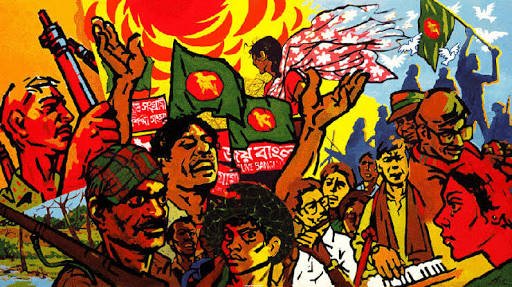Victoria Memorial of bangladesh

The Mukti Bahini (Bengali: মুক্তি বাহিনী[3] translates as Freedom Fighters, or Liberation Forces;[4] also known as the Bangladesh Forces) is a popular Bengali term which refers to the guerrilla resistance movement formed by the Bangladeshi military, paramilitary and civilians during the War of Liberation that transformed East Pakistan into Bangladesh in 1971.[5] An earlier name Mukti Fauj was also used.[6]
On 25 March 1971 Sheikh Mujibur Rahman issued a call to the people of East Pakistan to prepare themselves for an all-out struggle.[7] Later that evening resistance demonstrations began,[citation needed] and the military began a full-scale retaliation with Operation Searchlight, which continued through May 1971.[7]
A formal military leadership of the resistance was created in April 1971 under the Provisional Government of Bangladesh. The military council was headed by General M. A. G. Osmani[8] and eleven sector commanders.[9] The Bangladesh Armed Forces were established on 4 April 1971. In addition to regular units, such as the East Bengal Regiment and the East Pakistan Rifles, the Mukti Bahini also consisted of the civilian Gonobahini (People's Force).[10] The most prominent divisions of the Mukti Bahini were the Z Force led by Major Ziaur Rahman, the K Force led by Major Khaled Mosharraf and the S Force led by Major K M Shafiullah. Awami League student leaders formed militia units, including the Mujib Bahini, the Kader Bahini and Hemayet Bahini.[9] The Communist Party of Bangladesh, led by Comrade Moni Singh, and activists from the National Awami Party also operated several guerrilla battalions.[11]
The Mukti Bahini has been compared with the French Resistance[12] as both fought for liberation of their countries and the Viet Cong[13] as a popular resistance movement. Using guerrilla warfare tactics, it secured control over large parts of the Bengali countryside. It conducted successful "ambush and sabotage" campaigns,[14] and included the nascent Bangladesh Air Force and the Bangladesh Navy. The Mukti Bahini received training and weapons from India,[15] where people in the eastern and northeastern states share a common Bengali ethnic and linguistic heritage with East Pakistan.[16]
During the Indo-Pakistani War of 1971, the Mukti Bahini became part of the Bangladesh-India Allied Forces.[17] It was instrumental in securing the Surrender of Pakistan and the liberation of Dacca and other cities in December 1971.[17][18]
i love bangladesh
Vote comment me
okk bro
nice post..
upvord me plz.
https://steemit.com/@alamin22
okk bro
Joy bangla